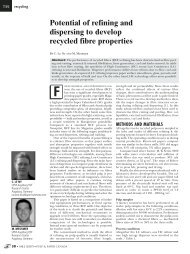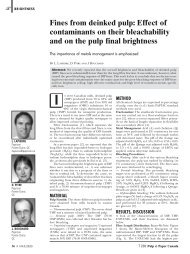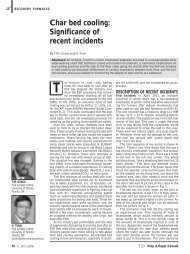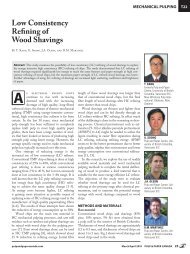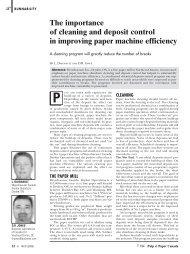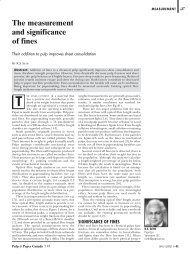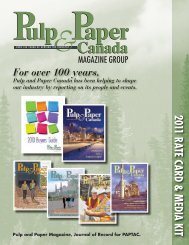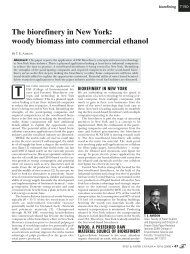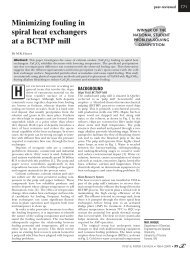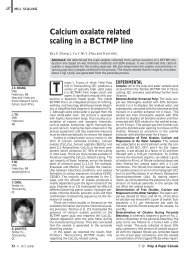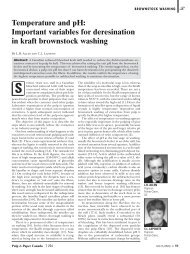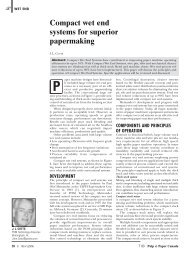Improving the strength properties of TMP - Pulp and Paper Canada
Improving the strength properties of TMP - Pulp and Paper Canada
Improving the strength properties of TMP - Pulp and Paper Canada
Create successful ePaper yourself
Turn your PDF publications into a flip-book with our unique Google optimized e-Paper software.
REFINING<strong>Improving</strong><strong>the</strong> <strong>strength</strong> <strong>properties</strong><strong>of</strong> <strong>TMP</strong>By K.B. Miles <strong>and</strong> I. OmholtAbstract: In order to develop <strong>the</strong> quality <strong>of</strong> <strong>TMP</strong> while limiting <strong>the</strong> drop in fibre length, <strong>the</strong> refiningintensity was reduced in <strong>the</strong> second <strong>and</strong> third stages during pilot-scale refining trials, by reducing<strong>the</strong> rotational speed from 1,200 to 900 rpm. The tear index <strong>and</strong>, in some cases <strong>the</strong> TEA indeximproved. Similar bulk <strong>and</strong> air resistance were reached at higher long-fibre content, indicating that<strong>the</strong> fibres were well developed. Both spruce <strong>and</strong> pine were investigated.K.B. MILESPapricanPointe-Claire,QCI. OMHOLTPapricanPointe-Claire, QCiomholt@paprican.caHE specific energy consumption associatedwith <strong>the</strong>rmomechanical pulp-Ting is high <strong>and</strong> has long been a matter<strong>of</strong> concern. However, <strong>the</strong> mainpriority is still to maintain <strong>the</strong> pulpquality. In cases where serious fibre shorteningoccurs, or in cases where <strong>the</strong> <strong>strength</strong> <strong>properties</strong>periodically drop due to wood quality variations,<strong>the</strong> problem may become <strong>the</strong> inability to applyenough energy to obtain <strong>the</strong> required pulp qualitybefore <strong>the</strong> target CSF value is reached.This paper describes experimental work donein a <strong>TMP</strong> pilot plant with <strong>the</strong> objective <strong>of</strong> showinghow <strong>the</strong> quality can be improved by increasing<strong>the</strong> energy application through reducing <strong>the</strong>intensity in <strong>the</strong> second <strong>and</strong> third refining stage. Itrepresents <strong>the</strong> continuation <strong>of</strong> earlier work atPaprican, investigating <strong>the</strong> potential <strong>of</strong> refining atreduced rotational speed [1,2].Many results have been published from workdone to explore <strong>the</strong> effect <strong>of</strong> varying intensity in<strong>the</strong> primary stage. In a few pilot studies, <strong>the</strong> intensityin <strong>the</strong> post primary stages was investigatedspecifically by increasing it over conventional levels.This generally led to reduced length weightedaverage fibre length [3], reduced long fibre<strong>and</strong> shive content [4,5,6] <strong>and</strong> lower CSF [4,5] ata given energy consumption. Reduced tear indexat a given breaking length has been shown <strong>and</strong> ithas also been observed that breaking length <strong>and</strong>burst could suffer, depending to some extent on<strong>the</strong> wood specie [4,6].BACKGROUNDRefining intensity is defined as <strong>the</strong> specific energydelivered per bar impact, <strong>and</strong> at a given consistencyit is proportional to <strong>the</strong> square <strong>of</strong> <strong>the</strong>rotational speed [7]. Fibre development dependsupon <strong>the</strong> material’s ability to deform <strong>and</strong> absorbthis energy at impact stresses below <strong>the</strong> point <strong>of</strong>fibre cutting. Through a high number <strong>of</strong> impacts,<strong>the</strong> fibre wall will become fatigued, <strong>the</strong> outerfibre layers will be loosened <strong>and</strong> partly peeled <strong>of</strong>f,forming fines <strong>and</strong> ribbon-like material. This isillustrated in Fig. 1.Based upon <strong>the</strong> physical relationship equatingwork to <strong>the</strong> product <strong>of</strong> pressure <strong>and</strong> volumechange, <strong>the</strong> stress developed during compression<strong>of</strong> any material is a function <strong>of</strong> <strong>the</strong> absorbed energydivided by <strong>the</strong> deformation. For practical pur-poses, <strong>the</strong> unstressed initial bulk is indicative <strong>of</strong><strong>the</strong> potential for such deformation, <strong>and</strong> so <strong>the</strong>stresses acting upon impact are related to <strong>the</strong> ratio<strong>of</strong> refining intensity to bulk. As specific energyaccumulates <strong>and</strong> <strong>the</strong> fibres become more developedduring <strong>the</strong> refining process, <strong>the</strong> uncompressedbulk decreases <strong>and</strong> <strong>the</strong> potential fordeformation during <strong>the</strong> impact is reduced. If <strong>the</strong>average refining intensity is kept on <strong>the</strong> same levelin all <strong>the</strong> refining stages, impact stress will thusrise for each stage. Consequently, <strong>the</strong> risk <strong>of</strong>exceeding <strong>the</strong> fibre wall <strong>strength</strong> <strong>and</strong> ultimatelyreducing <strong>the</strong> fibre length, will increase. It isimportant to keep in mind that <strong>the</strong> absolute ability<strong>of</strong> <strong>the</strong> material to absorb energy, to deform <strong>and</strong>to withst<strong>and</strong> stress without severe fibre shortening,probably also depends on <strong>the</strong> temperature <strong>and</strong> on<strong>the</strong> inherent wood related fibre <strong>properties</strong>.The principle <strong>of</strong> this relationship can be illustratedusing <strong>the</strong> results from a high-speed impacttester [8]. The apparatus delivers an impact to apulp pad at a speed comparable to that <strong>of</strong> a refiner.By increasing <strong>the</strong> air pressure acting on <strong>the</strong>piston, impact velocity <strong>and</strong> energy are increased.As seen in Fig. 2, at a given air pressure, or impactenergy, <strong>the</strong> stress upon <strong>the</strong> pulp pad increaseswith decreasing bulk value.The stress on <strong>the</strong> material at a given bulk maybe reduced by reducing <strong>the</strong> average refiningintensity according to this relationship. Even if<strong>the</strong> forces in <strong>the</strong> refiner may act on each fibrefrom many different directions simultaneously,our hypo<strong>the</strong>sis is that <strong>the</strong> stress level would still bereduced. This would potentially lead to a higherlong fibre content at equal bulk, as shown in Fig.3, where h<strong>and</strong>sheet bulk has been taken to represent<strong>the</strong> bulk <strong>of</strong> <strong>the</strong> material in <strong>the</strong> refiner.From <strong>the</strong> foregoing it is likely that when higherquality is needed, application <strong>of</strong> <strong>the</strong> additionalenergy could be facilitated by reducing <strong>the</strong>average refining intensity in <strong>the</strong> post primarystages <strong>of</strong> <strong>the</strong> process. This was <strong>the</strong> approachexplored in <strong>the</strong> series <strong>of</strong> pilot plant trialsdescribed below.EXPERIMENTALUnless o<strong>the</strong>rwise specified, <strong>the</strong> pulps were producedfrom black spruce on Paprican’s <strong>TMP</strong> pilotplant. The primary refiner is a pressurizedAndritz 22-1CP single disc refiner, preceded by an46 ❘❘❘ 105:5 (2004) T 123 <strong>Pulp</strong> & <strong>Paper</strong> <strong>Canada</strong>
REFININGFIG. 1. Example <strong>of</strong> well-developed <strong>TMP</strong> fibres produced in<strong>the</strong> pilot plant (black spruce, low refining intensity, totalspecific energy 7,088 kWh/odt applied in four stages).FIG. 2. The stress on <strong>the</strong> pulp pad during high-speedimpact testing increases with stepwise increments in <strong>the</strong>air pressure acting on <strong>the</strong> piston. The stress level at a givenair pressure increases with increasing specific energyconsumption <strong>and</strong> decreasing uncompressed bulk <strong>of</strong> <strong>the</strong>pulp. The basis weight <strong>of</strong> <strong>the</strong> pad was 300 g/m 2 <strong>and</strong> <strong>the</strong>consistency 30%. The pulp was produced from blackspruce at Paprican’s <strong>TMP</strong> pilot plant.FIG. 3. As <strong>the</strong> refining intensity is reduced by reducing <strong>the</strong>refiner rotational speed from 1,500 to 900 rpm, <strong>the</strong> longfibre content will be maintained at a higher level as <strong>the</strong>bulk is reduced by increasing <strong>the</strong> refining energy.FIG. 4. As <strong>the</strong> rotational speed <strong>of</strong> <strong>the</strong> refiner was reduced,<strong>the</strong> specific energy consumption at a given freenessincreased. The effect became particularly evident at low CSF.inclined preheater fed, in turn, by a plugscrew. Chip steaming conditions wereei<strong>the</strong>r 250 kPa for 100 seconds or 400 kPafor 20 seconds. All pressures are given asgauge pressure. In <strong>the</strong>se trials a relativelyconventional level <strong>of</strong> refining intensitywas maintained in <strong>the</strong> primary refiner byoperating it at a rotational speed <strong>of</strong> 1,800rpm <strong>and</strong> discharge consistency <strong>of</strong> 25-30%.The feed rate was in <strong>the</strong> range <strong>of</strong> 2.28-3.74odt/d. Generally, about 1,000 kWh/odtwere applied in this stage.Several additional levels <strong>of</strong> specificenergy were applied in <strong>the</strong> secondaryrefiner, comprised <strong>of</strong> an atmospheric doubledisc Bauer 400 operated at a target dischargeconsistency <strong>of</strong> 25% <strong>and</strong> feed rate <strong>of</strong>3.62 odt/d. In this unit a conventional level<strong>of</strong> refining intensity was obtained byoperating at its normal rotational speed <strong>of</strong>1,200 rpm. Low intensity refining wasachieved by reducing <strong>the</strong> speed to 900rpm. Lower intensity could also beachieved by increasing <strong>the</strong> consistency, butthis involves more steam production at agiven specific energy. At <strong>the</strong> long residencetime resulting from <strong>the</strong> combination<strong>of</strong> a substantially lower refining intensity<strong>and</strong> high specific energy, this approachleads to increased interference betweensteam <strong>and</strong> pulp flow. Speed reduction is,<strong>the</strong>refore, a more appropriate choice forlowering <strong>the</strong> intensity under <strong>the</strong>se circumstances.In addition, higher consistency isnot an option for large commercial refinersalready running at near maximumpractical levels <strong>of</strong> consistency. In one <strong>of</strong><strong>the</strong> trials described here, a relatively highlevel <strong>of</strong> secondary intensity was obtainedby operating at 1,500 rpm. When extremelyhigh energy levels were required, thisrefiner was also employed to do a thirdstage at <strong>the</strong> same refining intensity as <strong>the</strong>second. The plate patterns used wereD17C002 <strong>and</strong> 36104 (NiHard) for <strong>the</strong>Andritz <strong>and</strong> <strong>the</strong> Bauer refiner respectively.The pulp was screened on a Somervillescreen (0.15-mm slots) before testing.The tests were done according to PAPTACst<strong>and</strong>ard methods. The length weightedaverage fibre length was measured onunscreened pulp using <strong>the</strong> Fibre QualityAnalyser.RESULTSVarying Secondary Refining Intensity:Beginning with primary pulp in which <strong>the</strong>chips had been steamed for 100 secondsat 250 kPa, some over-all assessment <strong>of</strong> <strong>the</strong>effects <strong>of</strong> varying secondary refiningintensity were obtained by operating <strong>the</strong>second stage refiner at speeds <strong>of</strong> 900,1,200 <strong>and</strong> 1,500 rpm. The relationship<strong>Pulp</strong> & <strong>Paper</strong> <strong>Canada</strong> T 124 105:5 (2004) ❘❘❘ 47
REFININGFIG. 6. The long fibre content at a given energy level correlateswell with <strong>the</strong> refining intensity. The error bars represent<strong>the</strong> 95% confidence interval <strong>of</strong> <strong>the</strong> regression linesused for <strong>the</strong> interpolation.FIG. 5a <strong>and</strong> 5b. The long fibre content <strong>and</strong> <strong>the</strong> averagelength weighted fibre length were maintained at a higherlevel when <strong>the</strong> rotational speed <strong>of</strong> <strong>the</strong> refiner was reduced.FIG. 7. The amount <strong>of</strong> specific energy necessary to reach agiven freeness is related to <strong>the</strong> long fibre content. Thetrend is supported by data from mill <strong>TMP</strong> <strong>and</strong> RMP madein Paprican’s pilot plant, all made from black spruce.FIG. 8. Reducing <strong>the</strong> refiner rotational speed in <strong>the</strong> second<strong>and</strong> third stages resulted in higher long fibre content at agiven CSF. All pairs <strong>of</strong> runs were done with different batches<strong>of</strong> chips.between freeness <strong>and</strong> specific energy is shown in Figure 4. It isclear that <strong>the</strong> reduced intensity resulting from lower secondaryrotational speed brings <strong>the</strong> pulp to a given freeness with morespecific energy in it as intended. At 1,500 rpm <strong>the</strong> highest energytarget had to be reduced because <strong>of</strong> plate clearance limitations.If, as intended, <strong>the</strong> stresses on <strong>the</strong> material have beenreduced by using lower intensity, it should aid in <strong>the</strong> preservation<strong>of</strong> fibre length as more energy is applied. The plots <strong>of</strong> longfibre content against specific energy in Figure 5a <strong>and</strong> 5b demon-FIG. 9. Reducing <strong>the</strong> refiner rotational speed in <strong>the</strong> second<strong>and</strong> third stages resulted in higher long fibre content at agiven specific energy consumption. The first-stage samplefor each batch <strong>of</strong> chips, except for <strong>the</strong> second batch, isshown as <strong>the</strong> point at <strong>the</strong> lowest energy level.48 ❘❘❘ 105:5 (2004) T 125 <strong>Pulp</strong> & <strong>Paper</strong> <strong>Canada</strong>
REFININGFIG. 10. The tear index was higher at low intensity. Theeffect became evident in particular at high levels <strong>of</strong> burst.FIG. 11. In order to form a sheet with <strong>the</strong> same bulk withhigher long fibre content, <strong>the</strong> fibres have to be flexible <strong>and</strong>conformable. This was accomplished by <strong>the</strong> use <strong>of</strong> higherspecific energy.FIG. 12. The same air resistance could be reached at higherlong fibre content after low-intensity refining, indicatingthat <strong>the</strong> fibres were well developed.FIG. 13. There was no statistically significant difference inlight scattering coefficient between <strong>the</strong> two intensities.strate that this is <strong>the</strong> case.It can also be shown, as in Fig. 6, that<strong>the</strong> long fibre content at a given specificenergy is highly dependent on <strong>the</strong> refiningintensity used in <strong>the</strong> second stage. Therefining intensity is calculated accordingto [9].Ano<strong>the</strong>r relevant observation to bemade from Figs 5a <strong>and</strong> b, is that <strong>the</strong> actualdifference in fibre length <strong>and</strong> long fibrecontent between <strong>the</strong> different intensities,will depend on which energy level is usedfor <strong>the</strong> comparison.As previously discussed, <strong>the</strong> fatiguework required in order to flexibilize <strong>the</strong>long fibres <strong>and</strong> improve <strong>the</strong>ir bondingability, dem<strong>and</strong>s specific energy. This isquite evident in Fig. 7, which shows that<strong>the</strong> specific energy needed to achieve afixed freeness is well related to <strong>the</strong>amount <strong>of</strong> long fibre contained by <strong>the</strong>pulp at that freeness.Adding <strong>the</strong> points obtained from thisinvestigation to data from pilot plant RMP<strong>and</strong> three commercial <strong>TMP</strong> installations,produces a fairly well defined trend.High Quality, Low Freeness <strong>Pulp</strong>s: Thepotential benefits <strong>of</strong> using lower intensityto produce high quality, low freeness <strong>the</strong>rmomechanicalpulps were also investigated.In this case, a higher preheating temperaturewas used. To do this,conventional primary pulp made fromchips that had been presteamed for 20seconds at 400 kPa was put through twoadditional refining stages. One run wasalso done at 500 kPa at a primary energyconsumption <strong>of</strong> 569 kWh/odt. The second<strong>and</strong> third stages were done at a rotationalspeed <strong>of</strong> 1,200 rpm for <strong>the</strong> referencepulp <strong>and</strong> 900 rpm for <strong>the</strong>low-intensity pulp.Refining at 900 rpm yielded substantiallymore long fibre on <strong>the</strong> basis <strong>of</strong> ei<strong>the</strong>rfreeness or specific energy, as shown inFigs 8 <strong>and</strong> 9 respectively show. All pairs <strong>of</strong>runs were done with different batches <strong>of</strong>chips, which may explain <strong>the</strong> slight variationin response at 400 kPa. The change inlength weighted average fibre length generallyfollowed <strong>the</strong> same trend.The general effect for <strong>the</strong> black spruceruns seems to be that <strong>the</strong> difference inlong fibre content for <strong>the</strong> two refinerspeeds increased as <strong>the</strong> energy increased,confirming that <strong>the</strong> refining intensitybecomes more critical as lower levels <strong>of</strong>bulk are approached. Thus, as shown in<strong>the</strong> plot <strong>of</strong> Fig. 10, <strong>the</strong> energy needed toincrease burst can be applied with betterretention <strong>of</strong> tear <strong>strength</strong> at lower intensity.This was particularly evident in <strong>the</strong> trialdone at 500 kPa.Again, in addition to containing morelong fibre, it can be seen from Figs 11 <strong>and</strong>12 that pulps refined at low intensity cangive similar bulk <strong>and</strong> air resistance aspulps refined at conventional intensity.This indicates that <strong>the</strong>se fibres have beenwell developed.The shive content was slightly higherafter low intensity refining. The differenceswere in <strong>the</strong> range <strong>of</strong> 0.1-0.4 percentagepoints Somerville shives at a CSFlevel <strong>of</strong> 200 mL.Compared at a given CSF <strong>the</strong>re was nostatistically significant difference in lightscattering coefficient between <strong>the</strong> twointensities, as shown in Fig. 13.Low intensity refining gave higher TEAindex at a given CSF in some cases, but<strong>Pulp</strong> & <strong>Paper</strong> <strong>Canada</strong> T 126 105:5 (2004) ❘❘❘ 49
REFININGFIG. 14. Low intensity refining gave higher TEA index at agiven CSF in some cases.FIG. 15a. Low intensity refining gave a higher long fibrecontent at a given freeness. The first-stage sample isshown as <strong>the</strong> point at <strong>the</strong> highest freeness level.FIG. 15b. The jack pine used in this trial had low tracheidlength. The R28 fraction (R14 + 14/28) gave a more completeassessment <strong>of</strong> <strong>the</strong> differences in long fibre contentdue to <strong>the</strong> reduction in refining intensity.FIG. 16. As observed for spruce, pine had a higher longfibre content at a given bulk after low-intensity refining.not always, as illustrated in Fig. 14.Application to O<strong>the</strong>r Species: Initial studieshave also been carried out on woodspecies that traditionally provide <strong>TMP</strong> <strong>of</strong>poor quality. In this case, <strong>the</strong> structure <strong>of</strong><strong>the</strong> fibres <strong>the</strong>mselves or o<strong>the</strong>r factors maylimit <strong>the</strong> deformation available to controlrefining stress at conventional levels <strong>of</strong>refining intensity. Jack pine <strong>and</strong> sou<strong>the</strong>rnpine (loblolly pine) are representative <strong>of</strong>this class <strong>of</strong> raw materials. After conventionalprimary refining with chippresteaming for 20 seconds at 400 kPa<strong>the</strong>y were given second <strong>and</strong> third stagerefining at ei<strong>the</strong>r 1,200 rpm for reference,or at 900 rpm for low intensity. Thesepresteaming conditions were chosen inorder to provide a reference for <strong>the</strong> trialswith black spruce.Lower refining intensity improved <strong>the</strong>long fibre content at a given specific energyfor both jack pine <strong>and</strong> sou<strong>the</strong>rn pine<strong>and</strong>, as shown in Figs 15 <strong>and</strong> 16, resultedin considerably more long fibre at a givenfreeness or bulk. O<strong>the</strong>r <strong>properties</strong> alsoresponded in a generally similar mannerto those observed for black spruce. Thejack pine used in this trial had relativelyshort wood tracheid length, which is a possibleexplanation for <strong>the</strong> low over-all level<strong>of</strong> <strong>the</strong> long fibre content in <strong>the</strong> <strong>TMP</strong>. Measuredon kraft pulp cooked from <strong>the</strong>chips used in <strong>the</strong> refining trials, <strong>the</strong>length weighted average fibre length for<strong>the</strong> jack pine was 1.89 mm, compared with2.94 mm for <strong>the</strong> sou<strong>the</strong>rn pine. A level <strong>of</strong>2.30 - 2.45 mm was measured for blackspruce using <strong>the</strong> same method. Accordingto data shown by Gullichsen <strong>and</strong> Paulapuro(10), jack pine normally has tracheidsalmost as long as black spruce.DISCUSSION<strong>Pulp</strong> linting is <strong>of</strong>ten a concern regarding<strong>the</strong> quality <strong>of</strong> <strong>TMP</strong>. Previous work hasshown that linting can be reduced byincreasing <strong>the</strong> specific energy consumption[11]. At a given specific energy, <strong>the</strong>refiner rotational speed <strong>and</strong> <strong>the</strong> refiningconsistency did not seem to affect <strong>the</strong> risk<strong>of</strong> linting measured as <strong>the</strong> linting propensityindex (PLPI) [2,6,12].Ano<strong>the</strong>r important concern for highvalue paper grades is fibre rising caused bymoistening <strong>of</strong> <strong>the</strong> paper surface duringcoating <strong>and</strong> <strong>of</strong>fset printing. Fibre rising isrelated to reduced gloss <strong>and</strong> increased surfaceroughness. It may increase withincreased long fibre content, <strong>and</strong> seems toinvolve particularly thick walled fibres.However, increased fibre bonding abilitythrough refining will counteract this effect[13,14]. In an earlier study, both increasing<strong>the</strong> intensity in <strong>the</strong> first stage <strong>and</strong>increasing <strong>the</strong> specific energy consumptionproduced high long fibre quality,which reduced <strong>the</strong> changes in gloss <strong>and</strong>roughness on application <strong>of</strong> water. In <strong>the</strong>case <strong>of</strong> increased intensity, <strong>the</strong> fraction <strong>of</strong>long fibres was however somewhatreduced [15]. The advantage <strong>of</strong> lower postprimary intensity is its ability to extendgreatly <strong>the</strong> energy input when needed.CONCLUSIONLower rotational speed was used toreduce <strong>the</strong> refining intensity in <strong>the</strong> postprimary stages <strong>of</strong> <strong>TMP</strong>. This resulted in:• More long fibres compared at ei<strong>the</strong>r agiven freeness, at a given specific energy,or at a given bulk; <strong>and</strong>50 ❘❘❘ 105:5 (2004) T 127 <strong>Pulp</strong> & <strong>Paper</strong> <strong>Canada</strong>
REFINING• Better tear index at a given burst <strong>and</strong> insome cases improved TEA at a given CSF.It was also observed that <strong>the</strong> specific energyrequired to reach a given freeness, forblack spruce, is related to <strong>the</strong> amount <strong>of</strong> longfibre contained by <strong>the</strong> pulp at that freeness.This approach might be useful whenmore specific energy consumption isneeded, for example when refining lowquality wood, when attempting to improve<strong>the</strong> <strong>strength</strong> <strong>properties</strong> at a given CSF orwhen aiming for low CSF levels while preservinga high fibre length. The implicationscould, for example, be increased use<strong>of</strong> less desirable wood species in newsprintor reduced content <strong>of</strong> kraft pulp in higherquality paper.ACKNOWLEDGEMENTSThe contribution <strong>of</strong> Michael Stacey <strong>and</strong>Derek Dranfield in carrying out <strong>the</strong> trials,organizing <strong>the</strong> results <strong>and</strong> preparing diagramsis gratefully acknowledged. Theauthors also wish to thank Reza Amiri foruseful discussions.LITERATURE1. US Patent no. 6,336,602 B1 (2002).2. MILES, K.B., MAY, W.D., KARNIS, A., Refiningintensity, energy consumption, <strong>and</strong> pulp quality intwo-stage chip refining, Tappi J. 74 (3): 221-230(1991).3. KURE, K.-A., DAHLQUIST, G., HELLE, T., Morphologicalcharacteristics <strong>of</strong> <strong>TMP</strong> fibres as affected by<strong>the</strong> rotational speed <strong>of</strong> <strong>the</strong> refiner, Nord. <strong>Pulp</strong> Pap. Res.J. 14 (2): 105-110 (1999).4. MILES, K.B., KARNIS, A., The response <strong>of</strong> mechanical<strong>and</strong> chemical pulps to refining, Tappi J., 74 (1):157-164 (1991).5. CHAPMAN, D.L.T., ALLAN, R.S., Some basic considerationsin groundwood rejects refining, <strong>Pulp</strong> <strong>Paper</strong>Can. 71 (8): 67-72 (1970).6. SINKEY, J., Mechanical pulp <strong>properties</strong> <strong>and</strong> distributionsas affected by refining conditions, Internationalsymposium on: Fundamental concepts <strong>of</strong> refining,Institute <strong>of</strong> paper chemistry, Appleton, WI, Sept.16-18 (1980).7. MILES, K.B., MAY, W.D., The flow <strong>of</strong> pulp in chiprefiners, J. <strong>Pulp</strong> Pap. Sci. 16 (2): J63-J72 (1990).8. AMIRI, R., HOFMANN, R., Dynamic compressibility<strong>of</strong> papermaking pulps, <strong>Paper</strong>i ja Puu, 85 (2): 100-106(2003).9. MILES, K.B., A simplified method for calculating<strong>the</strong> residence time <strong>and</strong> <strong>the</strong> refining intensity in a chiprefiner, <strong>Paper</strong>i ja Puu, 73 (9): 852-857 (1991).10. GULLICHSEN, J., PAULAPURO, H., ed. <strong>Paper</strong>makingScience <strong>and</strong> Technology. Book 6A. Chemical <strong>Pulp</strong>ing.Helsinki: Fapet Oy (1999).11. WOOD, J.R., KARNIS, A., Towards a lint-freenewsprint sheet, <strong>Paper</strong>i ja Puu, 59 (10): 660-674(1977).12. WOOD, J.R., KARNIS, A., Linting propensity <strong>of</strong>mechanical pulps, <strong>Pulp</strong> <strong>Paper</strong> Can. 93 (7): T191-T198(1992).13. HALLAMAA, T., HEIKKURINEN, A., Effect <strong>of</strong>fibre <strong>properties</strong> on sheet surface roughening, Proc.,International Mechanical <strong>Pulp</strong>ing Conference, SPCI,Stockholm, Sweden, 361-363 (1997).14. HOC, M., Fibre rising in papers containingmechanical pulp, Tappi J. 72 (4): 165-169 (1989).15. AMIRI, R., STEPIEN,G., WOOD, J.R., <strong>TMP</strong> processconditions to produce pulps for mechanicalprinting papers - Effects on surface <strong>properties</strong>, Proc.1996 <strong>Pulp</strong>ing Conference, Atlanta: TAPPI Press, Book1: 265-278 (1996).Résumé: Afin d’améliorer la qualité de la PTM tout en limitant la réduction de la longueur dela fibre, nous avons réduit l’intensité du raffinage aux deuxième et troisième stades lors d’essaispilotes sur le raffinage, en diminuant la vitesse de rotation de 1200 à 900 trs/min. L’indice dedéchirement et, dans certains cas, l’indice TEA se sont aussi améliorés. Une résistance au passagede l’air et un bouffant similaires ont été atteints à une teneur plus élevée en fibres longues, ce quiindique que les fibres étaient bien développées. Les essais ont porté sur l’épinette et le pin.Reference: MILES, K.B., OMHOLT, I. <strong>Improving</strong> <strong>the</strong> <strong>strength</strong> <strong>properties</strong> <strong>of</strong> <strong>TMP</strong>. <strong>Pulp</strong> & <strong>Paper</strong><strong>Canada</strong> 105(5): T123-128 (May, 2004). <strong>Paper</strong> presented at <strong>the</strong> 2003 Intl. Mechanical <strong>Pulp</strong>ing Conferencein Québec, QC, on June 2 to 5, 2003. Not to be reproduced without permission <strong>of</strong> PAP-TAC. Manuscript received on September 26, 2003. Revised manuscript approved for publicationby <strong>the</strong> Review Panel on November 21, 2003.Keywords: THERMOMECHANICAL PULPING, MECHANICAL PROPERTIES, BEATINGDEGREE, ROTATION, VELOCITY.<strong>Pulp</strong> & <strong>Paper</strong> <strong>Canada</strong> T 128 105:5 (2004) ❘❘❘ 51



